Jetty repairs for concrete

Abstract:
For the majority of existing reinforced concrete jetty / marine structures it is not economically feasible to provide an early warning of the risk of corrosion to the rebar during the ingress of aggressive salts through the cover of concrete provided around it. Hence, there is no other alternative but to check reactive corrosion monitoring which basically is solely dependent on the physical degradation of the steel reinforcement itself to indicate that the structure is showing signs of distress. This is a reality that at some stage or other the structure is in need of repairs. Hence, maintaining and repairing marine / jetty structures has been a recurring need owing to the natural degradation of materials and structure under the combined effects of various loads and environmental factors.
These marine structures are also susceptible to damage due to other factors namely fatigue, dropped loads, contact of vessel, erosion and many more abuse inflicted during the service life. These damages manifest into the widespread deterioration of these structure which needs apt repairs in due course of time. The environmental compulsions and the high cost of replacement gives no option but to repair and rehabilitate the existing jetty and the marine structures located near to land or far off.
The recent repair techniques now currently in practice use fly ash, condensed silica fumes that is conducive and critically review in synchronicity with mother-nature ways with caution. The modern techniques of the repairs / restorations and up-gradations also decimates time, reduces cost and is answers to depleting natural resources of the mother earth.
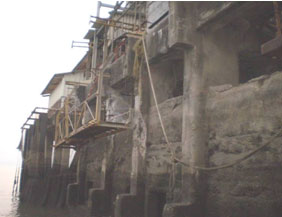 |
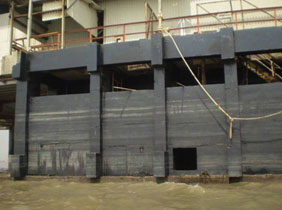 |
Distressed concrete jetty structure |
Restored concrete jetty structure |
The commonly applied whole life costing concept for the building as a whole, taking all stages from conception and design through to demolition into account, the concept could equally be applied to help make decisions for apt repair strategies for existing structures will ensure the engineers are more accountable to everyone concern including beneficiaries,
The targeted beneficiaries those should read this write up are the entire civil engineering fraternity, faculty, practicing consulting engineers, project managers / PMC, contractors, Clients who are in need of getting their jetties repaired or getting newly built, manufacturer of the construction chemicals, persons involved with research institute developing products and technology and civil engineering students.
Introduction:
Despite the fact that concrete is a reliable structural material with good durability performance, exposure to severe environments makes it vulnerable and other causes of degradation are lack of specifications and poor workmanship. The lack of knowledge of the deterioration mechanism results in insufficient planning and accounting for the environmental effects. Corrosion of reinforcing bars induced by chloride ion ingress is a major cause of damage in marine environments. Reinforcement corrosion causes reduction in the service life of reinforced concrete structures; therefore a regular schedule for maintenance and repair protocol is fundamentally important in controlling safe and efficient operation of a structure. Once a detailed investigation to determine the extent and cause of degradation has been conducted, corrosion damage assessment can lead to the selection of effective repair schemes. Regular inspections after repair work are necessary to ensure satisfactory performance of repair systems. In addition, field investigations of repaired concrete structures are necessary to develop guidelines for the adequate selection of concrete repair systems, improved repair procedures, extended durability of rehabilitated structures, and evaluation of discrepancies between laboratory results and field performance.
This paper presents a salient feature of major repairs to a concrete jetty structure used as pump-house is exposed to the severe marine environment of Arabian Sea. The structure showed extensive corrosion of reinforcing bars in splash zone, tidal zone, atmospheric zone but concrete in underwater zone was intact.
Preamble:
Maritime transport is a critical infrastructure for the social and economical development of our country. The capacity of the Indian Ports at the end of fiscal 2011-12 stood at 1,247 MPTA, which is likely to rise to 2,686 MPTA by 2017, the end of current five year Plan period. Fate of the few of the new ports project development hangs in balance as the port authority is not able to secure environment clearance for the project. Hence, as a policy the ports are currently being upgraded, maintained and up-keeping of ports to increase the volume of the freight being handled. For existing maritime structures deterioration of concrete structures has emerged as one of the most severe and demanding challenges.
One of the authors are in the field of repairs since 1983 onwards and have observed and experienced that the poor workmanship, ad-hoc attention of field staff about the specification, lack of supervision in each and every stage of construction has affected quality of hardened concrete. The inherent defects developed often are being concealed under external renderings and the defect takes time to manifest itself. In most of the structures efforts for measuring quality and quality assurance is restricted to casting of cubes which are tested as prescribed. The cube test performed is chief indicator for quality of concrete is normally incoherent when we observe concrete over a period. The inherent defects which are inbuilt lead to early occurrence of the repairs to the structures. The mechanics, derivation strategy, parameters, principles governing performance for repairs of marine structures may resemble with the new Construction but repairs / rehabilitation works differ from the new construction in several respects and in major fashion as listed below. These factors cannot be ignored or disregarded, though the repair techniques and sound practices adopted for the repairs are derivatives of new construction practices and techniques. Few of the glaring differences are:
. the project scales differs a lot in terms of quantum,
. technology management is fundamentally different,
. well established codes and standards are available for new constructions which is lacking in repair sector,
. quantum of material consumed in the desired repairs are very much on lower scales compared to new construction. |
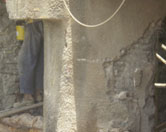 |
| |
Inappropriate repairs "Gunite" |
The jetty structural members when repaired and depending upon the placement / location and type of repair material selected are subjected to same degree of wrath and or operating conditions will determine if deterioration will occur. To add to the above, seasonal and diurnal fluctuations in marine conditions provide variability and direction of gradients. Predicting the fluctuations and accommodating them during design stage and in method statement of repairs is very important. The error in realizing these facts alone may be responsible for many premature failures. A rational approach to the repairs / restoration of jetty structures is to consider the source of problem and the symptom together. The repair strategy while replacing damaged portion of the reinforced concrete members need to adopt a cause and effect phenomenon. Failure on this account in strategy invites short lived repairs. Hence, a proper procedure needs to be developed. The jetty structure which is presented here was repaired number of times by adopting gunite technique which proved short durable and inappropriate. To repair the jetty in 2010 a modern technique with latest material and improvised method statement was adopted which proved very cost efficient repairs.
Jetty Structures:
The jetty is located in Mumbai near the port of Mumbai in Arabian Sea. The structural layout consists of two main parts which are the pump house structures right on jetty and pipe racks with carriage way. The pump house supplies cooling water of sea to the plants of refineries. The pump house consist of deep chambers housing four pumps, two intake cells, two balancing cells and pipe racks with its supporting piers and tie beams. For simplicity the jetty structure is assumed to be surrounded by four environmental zones namely: (1) Underwater zone; (2) Tidal zone; (3) Splash zone; and (4) Atmospheric zone.
Each zone for the structure has different requirements for repairs, different forms of damage and deterioration as well as different problem associated with it. The regular rise and fall of tide proved to be dominating factor for the deterioration of the jetty structure and not the wave action as it is close to shore.
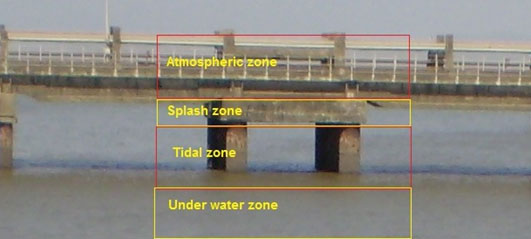
The marine structure born with inherent defects and subjected to environmental and other loads.
The diverse repair techniques has to be selected judiciously to limit conflicts among the clients, contractors, specialist contractors, material producers and expertise in the construction process with the ultimate aim of developing methodology that will facilitate best practice in concrete repairs.
To achieve above lot more work has to be done to provide skeletal in the form of developing repairs standards which will influence the selection of repair techniques. An effort was made to evolve the standard engineering practice on the appropriateness of repair techniques. The techniques dealt with all aspects right from surface preparations, renderings of the surface, including bonding coats, extent of repairs i.e. patch repairs / full extensive repairs, electrochemical process, restricting corrosion of steel i.e. corrosion inhibitors and desired surface treatments to corrosion this can be put into context with the total service life required for the structure.
Road map to achieve desirable and formidable repairs for existing jetty:
The jetty repairs were undertaken with following ultimate goal which was divided into various tasks.
§ Health and safety of all personnel; § Minimum degradation of environment; § Zero accidents project and goal of zero incidents; § Achieve in time completion; § Lasting repairs in demanding conditions; § Proactive planning and force majeure.
. The first step was to evaluate current condition of existing concrete. A review of structural design, details, structural instrumentation data, visual inspection, non-destructive tests, laboratory analysis and tests were assessed by the expert engineer. Authors is of the opinion that prior to the visual inspections it should be mandatory to clean the structure of marine growth and clear other deposits / fouling with help of hand cleaning with scrapers and wire brushes or use water-blasting jets and hydraulically and or pneumatically powered mechanical abrasive tools. It is vital in visual inspection.
. For underwater jetty structures visual inspection with experienced divers was sufficient. He took photographs / video of critical load bearing RCC members and studied conditions of piers which proved of immense information for the engineer to decide maintenance and / or the type of repairs.
. For structures in splash zone and above the detail examination / inspection of the marine structure begins with the visual inspection of each and every reinforced cement concrete members of existing jetty structure was mapped location wise on the drawings, recorded in videos / photographs.
. The second step was to relate data obtained from above to mechanism that causes the damage / deterioration. The competent person related observations to cause of damage. In compliance to the assessment for corrosion initiation phase more proactive maintenance program was worked out and in corrosion propagation phase more detailed repairs strategy was worked out. The classified damages were assessed as:
. The surface damage is superficial damage mainly due to shrinkage crack /cob web crack seen on surface and are not more than 1.5 mm deep and widths are less than 0.1 mm.
. Minor damage was defined as the damage restricted within cover concrete portion of the structure. Isolated cracks are seen and spalling of concrete is not more than 30mm. depth. No rebar are found corroded. It is important to restore concrete cover in order to prevent rebar from eventually becoming exposed to corrosion. The crack widths are narrow and are found in the range of = 0.1 mm and < 0.3 mm.
. Moderate damage consists of concrete cracks and wide spalls exposing reinforcing steel. The reduction in cross section of rebar are not more than 5%. There is no immediate effect on the structural capacity. Although cracks and exposed reinforcement can reduce structure life due to corrosion and freeze thaw action. The cracks widths are medium and in the range of = 0.3 mm and < 1.0 mm. The repair work should commence within one to six months or simultaneously with the major repairs works.
. Severe damage wherein crack widths are >1mm, the exposed rebar are found corroded. The damage to rebar along with loss of significant cross section and possible lateral mis-alignment due to distortion calls for urgent attention to primary structure as negligence can cause problem. The reduction in cross section of rebar are not more than 15%. The crack widths are wider than = 1.0 mm.
. Potentially hazardous damage wherein damages are wide spread and cracks are wider than 3mm. Main bars are found necked / reduced cross section more than 15%. Excessive deflection of the load bearing member of the RCC enclosure wall members was in hazardous condition and threatening stability of the structure leading to very high potential risk and was prone to affect public safety. The structural supports were provided immediately without any delay once damage was observed. The repair was commenced urgently and immediately within three months of the report submitted by the engineer. |
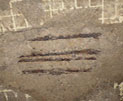 |
Rebar corroded < 5% |
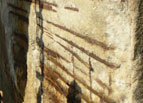 |
Rebar corroded > 15%. |
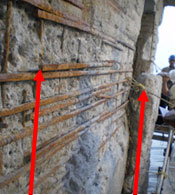 |
Flattened / necked bars & excessive
Deflection of wall |
Please note that the reliability of above data collected by inspection team which may consist of diver is very important and critical. Also to get 10% of the above data checked to ensure accuracy is vital. On observation of major discrepancy, all the data needs to be rechecked.
. Third step is to select most appropriate material, method statement and technology and apt quality control and quality assurance measures to repair the structure. The cause and effect plays a vital role and has place in above said material selection, method statement and technology. Optimisation of construction equipment requirement, enabling works and simplicity of construction / repair process are important considerations in design and method statement. When formulating specifications / method statement a focus on the ease, adaptability and simplicity of application in addition to performance will ensure structural safety and serviceability for durable and cost effective repairs.
. It is essential to devote resources to strike innovations by the manufacturer for developing construction material, modifiers and construction chemicals which can perform in the adverse conditions what these jetty structure is subjected to and matching steps from the engineers / constructors to evolve technologies to apply the material with apt and in cost effective manner. The role of the research institutes cannot be ignored and their role is to conduct experiments for research and development, product evaluation, developing test method, standards and decision / support tools. In the repairs to jetty extensively high strength non-shrink type of free flowing micro-concrete grout, rust passivators, corrosion protection polymer coatings, inhibitors, bonding coats, non-shrink type of polymer etc. have been used. Each and every product developed has shown good amount of versatility, strength and ease with it can be used etc. A recent survey after a span of five years have been carried out and repaired structural elements / members have shown immense amount of resilient, resistance to chemical action, and the client's awareness has been observed. No cracking and spalling has been observed in a span of five years.
.Challenges faced:
.The method statement should incorporate pre-repair adjustment, modifications, attachments required to remedy the damages inflicted on the structure. To highlight this point, say providing water tight gates to intake cell to facilitate water tight compartment which are located below lowest of the low tide zone to make an area accessible for internal repairs of intake cells. Changing water drainage system, strengthening pipe rack system, installing supports to support weak primary members, answers to restrained areas of work in the form of access, planning of shut down or alternative to shut downs, etc. . Fourth step is to provide access and approach to the work place and actual location. Suspended platforms, barge, pontoons or boat is normally employed to access work place to repair jetty / marine structures. It is very vital that the scaffold to be strong enough to take care of hostile environment, loading prevailing at the time of work which is in process. Suspended from deck slab which will give uninterrupted approach to the work place with ease and will help in longer way to achieve repairs longer lasting. The scaffold will preserve safe, healthy environment to protect every one against any potential hazard caused by collapse or mishaps of scaffold. . Fifth step is to provide efficient and correct enabling systems.
* The propping of the venerable members is must prior to removal of damaged concrete.
* Similarly, strutting / bearer beam system once intake cell is blocked to withstand against lateral pressure of water when if the cells are repaired internally.
* Equally important is to mobilize and provide dead weight to compensate for removal of damaged loose concrete to cater for buoyancy force.
* Likewise the shuttering provided for jacketing need to be redefined to make it water tight. Selection of bonding coat need to be compatible to timings to make shutter and pour concrete. |
 |
Access to the external façade suspended Platform |
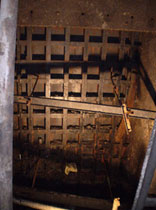 |
Water tight door provided at mouth
Of intake cells with horizontal supports
|
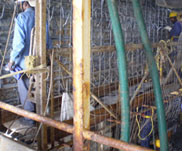 |
Surface preparation, shear connectors, additional Bars coated |
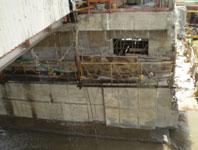 |
Structurally strengthened surface |
. Sixth step which has a vital role to play as surface preparation was a key to the success of repairs of the jetty structures. Removal of concrete till sound & chemically unaffected core and 6 mm beyond reinforcing bars ensures mechanical grip of substrates and removes concrete stained / or contaminated with oil/grease. Cleaning of the concrete surface and reinforcing steel through hydrodynamic removal of the deteriorated material with the high pressure water jet > 2000bar. The concrete and steel bars are brush blasted. Tensile strength of concrete substratum and adhesiveness of the concrete and reinforcing steel = 1.5 N/mm2. Surface roughness recommended depending on the repair mortar layer thickness according to international standards ISO 8501-1, SIS 05 59 00 1967, DIN 55 928-Teil 4, ASTM D 2200-67 depending on the cleaning method: sandblasting, shot blasting, hydro dynamically, manually. Surface thus obtained should be dressed evenly with an aim to prevent any high or low points. A proper seat is formed to receive renderings needs to be established by cutting or shaping pockets. Thus prepared substrates should be cleaned of dust and other loose material. Simultaneous rust removal and protective coats to rebar is also essential to ensure durable repairs. Protective coatings, including epoxies, galvanizing and some cementitious materials containing corrosion inhibitors, can be applied to the rebar to provide a barrier between it and the corrosive environment as per the specifications laid. The effectiveness of cementitious coatings is still under study, while opinion on the effectiveness of fusion bonded epoxy-coated reinforcement is mixed. This coating is possible with the new bars. There are still questions regarding debonding and pitting corrosion because the coatings have naturally occurring defective spots produced during fabrication or they may be damaged during transportation and handling. Zinc in galvanized form is another protective coating that can be used. It is applied to the rebar by hot dipping or cold application by simple spray for existing bars. Galvanized rebar is superior to carbon steel rebar; however, its protection against pitting and localized rusting in the presence of high chloride concentrations is somewhat limited. This technology will only delay or postpone the onset of cracking and spalling; it will not prevent them. More work has to be done to assess its effectiveness for corrosion protection.
. Seventh step is to render the surface (Seventh step to render surface use of high strength grout, polymer mortars, use of corrosion inhibitors.)
. Conclusion:
* The jetty structure which is constructed with insufficient planning, weak construction from the technical and construction point of view and lack of understanding of the durable aspects for concrete structures will come for a quicker deteriorations. The same jetty repaired with inappropriate repair material will be short lived.
* Chlorides in sea water coupled with environmental conditions namely relative humidity and temperature can collectively contribute to weakening the durability of concrete or rendered surface as they are subjected to same degree of fury coupled with operating conditions.
* Foreseeing these parameters and accounting them during design stage and in method statement of repairs is very important. The compatibility of repair material with parent material is an essential ingredient for successful repairs. The error in realizing these facts alone may be responsible for many premature failures. A rational approach to the repairs / restoration of jetty structures is to consider the source of problem and the symptom together. The repair strategy while replacing damaged portion of the reinforced concrete members need to adopt a cause and effect phenomenon.
* At present there are no objective, low-cost tools that provide accurate information about the corrosion state. Genuine efforts / research are needed in this direction by the research scholars.
* Corrosion inhibitors are a viable corrosion protection measures for long term. It functions better and efficient when used as a part of multiple strategy corrosion protection system.
* A caution if the repair material (ready to use) has high carbon content, high air entrained have limitations and need to be reduced and as it will use more water. It is not recommended to use a high-carbon (greater than 5 percent) content fly ash. Fly ash and slag in wet condition perform very well with significant increased durability. In dry condition, they do not have such benefits.
* Whole life costing concept provides a basis for comparing alternative repairs intervention strategies in order to identify the most economically advantageous option over a defined period. The benefits of adopting a whole life costing approach are:
. It provides a mechanism to evaluate competing repair options over a defined period of time.
. It ensures an increased awareness of the life cycle costs of different repairs options.
. It enables the demonstration (to decision-makers) of the long-term performance and economic implications of alternative treatment strategies and funding levels.
* NDT carried out during pre-repairs does assist assessing the damages in turn helps in framing best strategies and method statement. NDT appropriately correlated when carried out during repairs and after post repairs will assure best quality repairs which the consulting engineer can vouch, the Client is assured of the returns for which he has spent and the Contractor is proud of achieving it. At the end all the parties concerned are happy.
* The strategy of executing in appropriate repairs, superficial maintenance works with a view to minimise short-term expenditure would require frequent intervention and the asset would deteriorate over time and eventually require substantial works.
* The condition of portion of the jetty structure in under water zone was found relatively in good condition could be attributed to the fact that oxidation reaction was starved of oxygen which did not corrode bars.
|